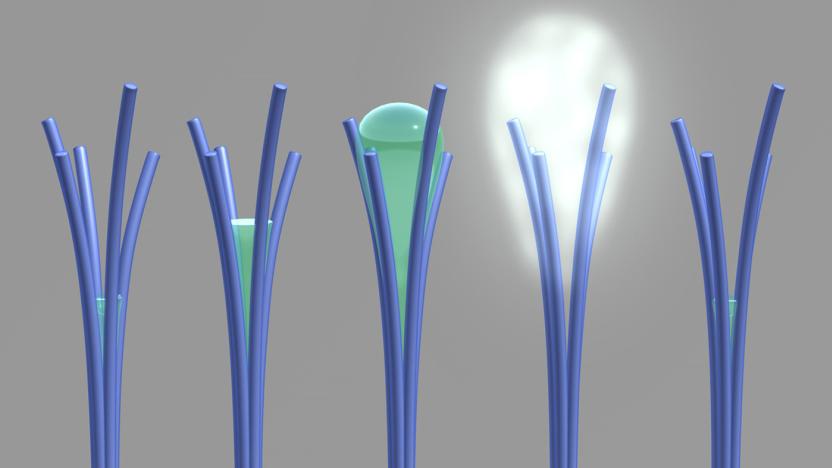TL16OOPS
Latest

Researchers accidentally turn carbon dioxide into ethanol
Science has a long and storied history of looking for one thing but finding something better instead. Penicillin, radioactivity, science boxes...I mean microwave ovens -- all of these discoveries came in the the search for something else. On Monday, researchers at the Oak Ridge National Laboratory in Tennessee announced that they too had unintentionally discovered something incredible: a means of transforming carbon dioxide directly into ethanol using a single catalyst.

MIT accidentally discovered a cleaner smelting process
Sometimes, science can take an unexpected turn. While trying to develop a new kind of high temperature storage battery, MIT researchers accidentally stumbled upon a new, more efficient process for smelting metal -- one that's potentially cheaper, safer and less harmful to the environment than traditional ore processing.

Nanorods could harvest water in dry climates
Sometimes it's the accidental discoveries that make the biggest impact. Researchers at Pacific Northwest National Laboratory have learned that carbon-rich nanorods created in a botched experiment might be ideal for harvesting water. When there's relatively low humidity (below 50 percent), the rods trap water inside their gaps; if it's any more humid, however, they promptly expel that water as vapor. It's a very unusual trait that's likely caused by water condensing into a "bridge" in the nanorods, whose surface tension forces them to close and eventually kick the water out.

Accidental discovery could help batteries last years longer
Today, most smartphone and device batteries are made from lithium and slowly lose capacity over thousands of recharges. Researchers at UC Irvine built a battery that substituted gold nanowire in electrolyte gel for the lithium and lost barely five percent battery capacity over 200,000 charge cycles — but they aren't totally sure how it worked.

Astronomers accidentally discovered the brightest pulsar on record
Remember NuSTAR, the specialized space telescope NASA designed specifically to study black holes? It just found something much, much brighter. Astronomers at NASA have stumbled upon what appears to be the most luminous pulsar ever discovered, but they almost mistook it for a black hole. After measuring the dead star's output, they found it was outputting as much energy as 10 million suns -- shockingly powerful, considering how much smaller it is than our own star. Astronomers aren't sure why the pulsar is so bright, but will continue to study in hopes of learning how common or uncommon this kind of pulsar is. The discovery kind of shakes up what theorist knew about black holes and ultraluminous x-rays, underlining how little we really know about the universe out there. Check out NASA's gallery of images at the source link below.

How a water bottle gave birth to a whole new world of self-healing products
IBM's had a breakthrough in accelerated materials science and it's owed, in part, to a Dasani water bottle. It sounds simplistic, but the discovery of a new polymer that's not only super strong, but can also be made to be flexible and self-healing really was the happy accident of one researcher's focus on "green" chemistry and recyclable materials (i.e., plastic water bottles). Dr. Jeannette Garcia, a principal researcher for the project, was in the lab experimenting with the creation of high-performance materials when she stumbled upon this new polymer. "I made an error weighing out one of my starting materials and found that... [the new material] plugged up," she said. That resulting substance was so tightly bonded, Garcia had to smash the flask with a hammer just to get it out. She also tried hitting the substance with the hammer to see if it would break. It didn't.

NASA accidentally improves weather forecasting with lunar dust-measuring lasers
Anyone that's ever tried to plan an outdoor activity in advance knows that weather forecasting is not an exact science, but the perpetual sky-watchers at NASA may have inadvertently found a way to improve these guesstimations. They have been testing a laser system for measuring lunar dust and soil kicked up by rocket exhausts, and while using precipitation as a substitute to calibrate the laser, they found they could measure the average size of raindrops passing through it. This value is estimated in current forecasting models, so plugging in some accurate numbers should make those predictions more reliable. The original mission hasn't been forgotten, though. Particles whipped up by landing rockets on the moon's surface could damage what was left behind by the Apollo missions, ruining its scientific and historic value. One of the laser sensors may find its way onto a craft vying for Google's X Prize, with the results used to determine where vessels can touch down whilst keeping a safe distance from Apollo landing sites. Although an accidental discovery, the system's other potential career in weather forecasting will also continue to be explored. Now, if only there was a way to make it rain and speed up the testing.





